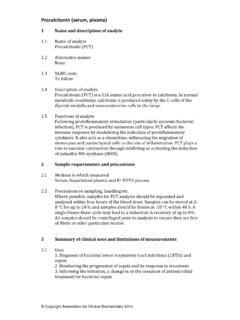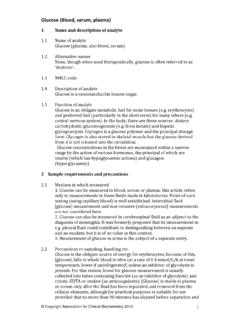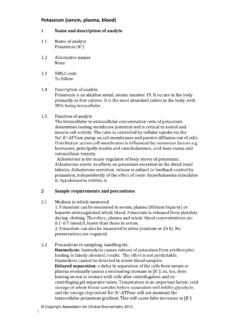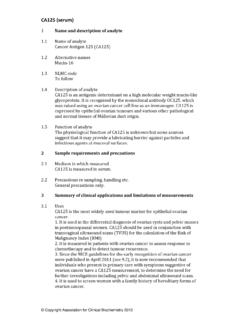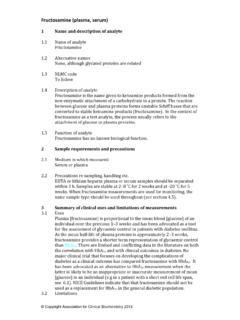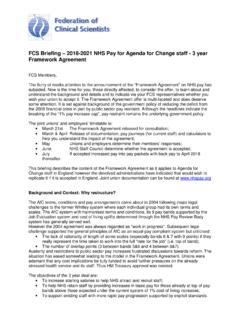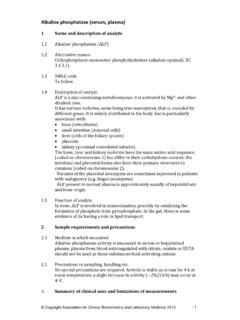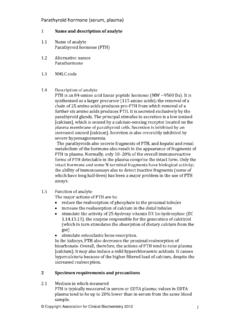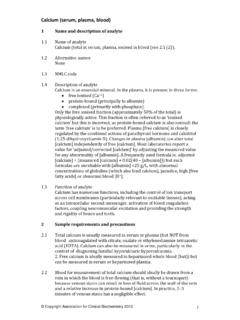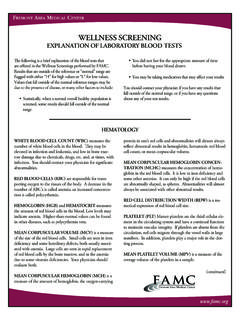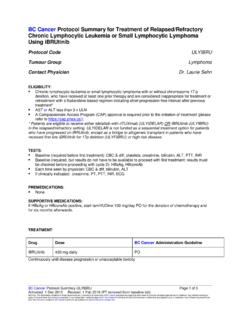Transcription of Total protein (serum, plasma) - Association for Clinical ...
1 Copyright Association for Clinical Biochemistry 2012 Total protein ( serum , plasma ) 1 Name and description of analyte Name of analyte Total protein Alternative names None NMLC code Description of analyte This is a quantitative measurement of the concentration of all proteins present in serum (note that this excludes clotting factors). The major proteins are albumin and the immunoglobulins (principally IgG, IgA and IgM). Many other proteins are included in the measurement but individually none contributes more than 5% of the Total , and most much less. Function of analyte For albumin, see separate entry. The immunoglobulins are components of the humoral arm of the immune system.
2 2 Sample requirements and precautions Medium in which measured serum ; plasma can be used but concentrations are lower owing to the lack of clotting factors. Total protein can also be measured in urine and cerebrospinal fluid. Precautions re sampling, handling etc. 1. plasma protein concentrations increase with excessive stasis during venepuncture; blood should therefore be collected with a minimum of stasis. 2. No other special precautions apply. 3 Summary of Clinical uses and limitations of measurements Uses 1. Total protein is measured in serum to give an indication of Total immunoglobulin concentration since ([ Total protein ] [albumin]) = [globulins] of which the major component is immunoglobulins.
3 2. Total protein is sometimes included in the liver function tests ; some chronic liver diseases cause increases in [immunoglobulins], which increases Total protein (though this may be offset by a decrease in [albumin]). 3. Total protein should be measured in suspected humoral immunodeficiency, for which the definitive diagnosis is by measurement of individual immunoglobulins. 4. Total protein can be measured when a patient is suspected of having a paraprotein but is not always high; the definitive investigation for Copyright Association for Clinical Biochemistry 2012 paraproteinaemia is serum protein electrophoresis. Note that urine protein electrophoresis should also be performed in suspected myeloma.
4 Limitations Total protein measurement is of little value without simultaneous measurement of albumin. 4 Analytical considerations Analytical methods Total protein in serum can be measured by a variety of methods, including chemical methods, turbidimetry and nephelometry. The most widely used is a method based on the biuret reaction, in which an alkaline copper (II) solution reacts with peptide linkages to form a complex that absorbs light at wavelength 540 nm. The sensitivity of the reaction can be increased by the addition of phosphotungstomolybdic acid (Folin Ciocalteu reagent, phenol reagent) (Lowry method), which, together with other modifications, results in increased absorption for a given amount of protein .
5 The reactivity of the various plasma proteins to the biuret reagent is not significantly different, since it is dependent on the number of peptide linkages, not on amino acid composition. The response is linear from [ Total protein ] 15 g/L to at least 120 g/L. The reference method is based on the biuret reaction. The reference material is purified human serum (ERM/IFCC DA470K: Institute for Reference Materials and Measurements, Belgium). Interference Causes include: bilirubin: [bilirubin] 500 mol/L causes up to 4% negative interference haemoglobin: [Hb] 10 g/L causes up to 6% positive interference lipaemia causes negligible interference. Sources of error.
6 The biuret reaction is a robust procedure and not subject to significant sources of error. 5 Reference intervals and variance Reference interval (adults): 60 80 g/L Reference intervals (others): lower in the newborn rising to adult values by age 3 years Extent of variation Interindividual CV: Intraindividual CV Index of individuality: CV of method: Critical difference: 10% Sources of variation: 1. serum [ Total protein ] is affected by hydration state. 2. serum [ Total protein ] can be up to 10% higher when an individual is ambulant than when recumbent. Copyright Association for Clinical Biochemistry 2012 6 Clinical uses of measurement and interpretation of results Uses and interpretation 1.
7 Although often included in the standard panel of liver function tests (see (1)), [ Total protein ] does not reflect liver function, but may, when used to derive [ Total globulins] suggest the presence of an autoimmune component to chronic liver disease. Thus IgM tends to be raised in primary biliary cirrhosis, IgG in autoimmune chronic hepatitis and IgA in alcoholic liver disease. Autoimmune serology and other investigations are required for diagnosis. 2. serum [ Total globulins] may be low in patients with humoral immunodeficiency (primary or secondary) but because IgG is the major component, deficiencies of IgA or IgM may not significantly affect [ Total globulin]. If immunodeficiency is suspected, individual immunoglobulin classes should be measured.
8 3. serum [ Total globulin] is typically, though not constantly, raised in patients with autoimmune disease, chronic inflammation and paraproteinaemia. More specific investigations are required for diagnosis. 4. serum Total protein is often measured routinely , without a specific indication (see and ). Confounding factors serum [ Total protein ] is affected by the patient s state of hydration; meaningful interpretation of results requires that a patient s hydration state is normal. 7 Causes of abnormal results High values Causes: dehydration ([albumin] likely to be elevated also) chronic infection/inflammation osteomyelitis, endocarditis. autoimmune disorders rheumatoid disease, systemic lupus erythematosus (but not organ specific autimmune diseases, excepting autoimmunehepatitis paraproteinaemia (myeloma and other causes).)
9 Investigation A high [ Total protein ] in a normally hydrated patient suggests high [immunoglobulins]. Unless there is an obvious cause ( chronic infection, chronic liver disease) serum protein gel electrophoresis (see ) is required. Typical patterns observed include: a polyclonal increase (no discrete bands, characteristic of chronic inflammation and autoimmune disorders) one or more (oligoclonal) bands on the background of a polyclonal increase (an occasional finding in autoimmune disease or infection) a monoclonal band or paraprotein (characteristic of haematological malignancy, especially myeloma but sometimesdue to monoclonal gammopathy of uncertain significance (MGUS).)
10 With malignant paraproteins, the concentration of normal immunoglobulins may be decreased (pale staining background); this is termed immune paresis. Copyright Association for Clinical Biochemistry 2012 Low values Causes Low [ Total protein ] only occurs as a result of conditions causing low values of the major components, albumin and the immunoglobulins (particularly IgG). A low [ Total protein ] but normal [albumin] may be the first indication that a patient has humoral immunodeficiency. Investigation Low [albumin] will be apparent from its specific measurement. Suspected immunoglobulin deficiency is diagnosed from measurements of the individual immunoglobulin classes (IgG, IgA, IgM).
